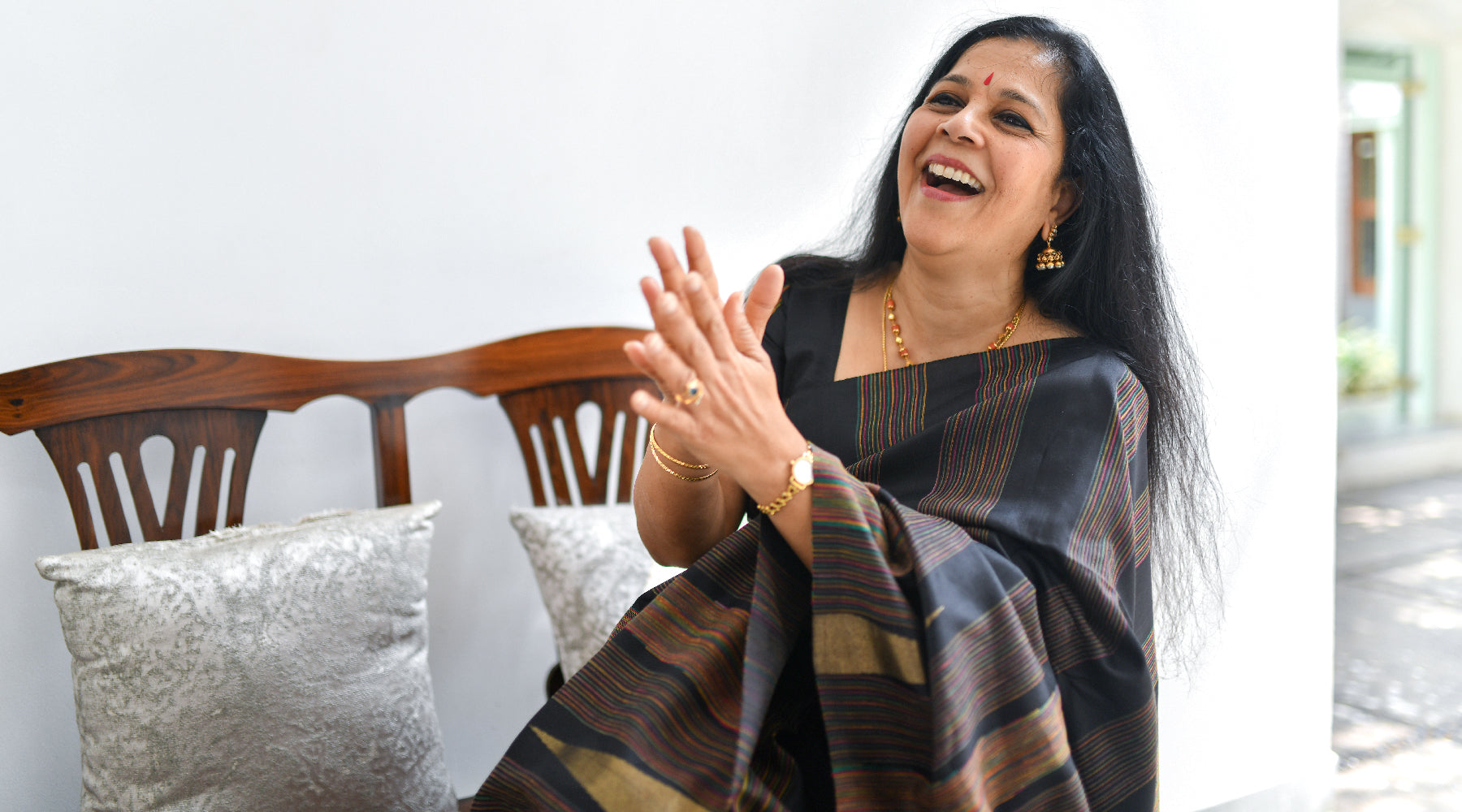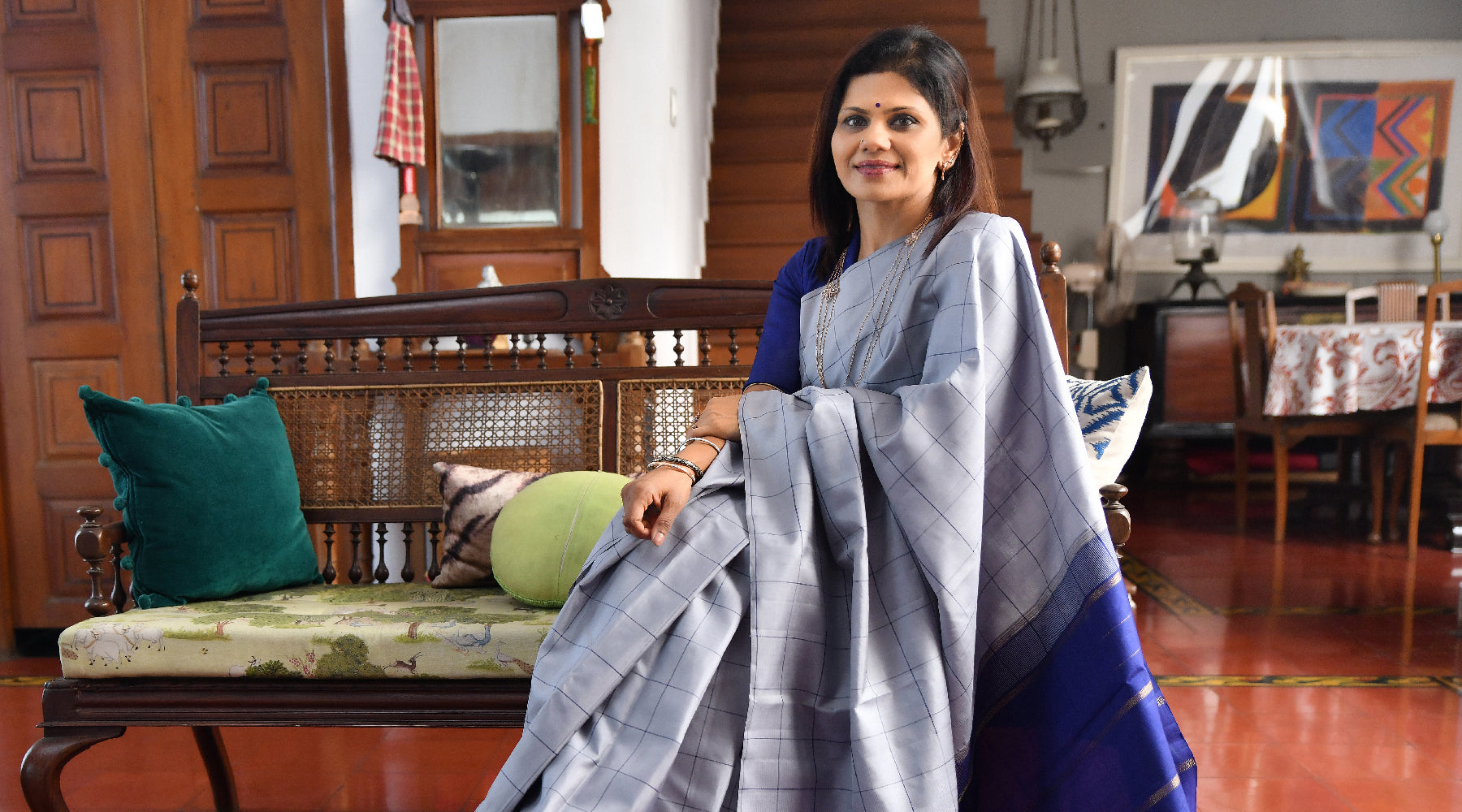KANAKAVALLI VIGNETTES : Radhe Jaggi - On The Road

In Kanakavalli’s March Vignette, we meet Radhe Jaggi, a Bharatanatyam dancer who believes that the classical arts are truly contemporary in their grammar and expression. In a conversation that spans the past and the present, Radhe reminisces about a childhood spent climbing trees, and on the road with her father, Sadhguru Jaggi Vasudev. For her, travel is a way of life, and she continues to love being on the move, whether trekking in the mountains or scuba diving off remote islands. Speaking to Aneesha Bangera of the Kanakavalli Journal, Radhe talks about being given the freedom to make unconventional choices at a very young age, about watching her father’s aesthetic unfold through his attention to detail, and about being drawn to the powerful potential of solo performance in dance. For Radhe, beauty is intangible and intensely personal. She describes her ‘love affair’ with the sari, curating a selection of vibrant kanjivarams from the Kanakavalli repertoire, each a reflection of her passion for the weave.
On The Road
Did you always want to become a dancer? Tell us how you found Bharatanatyam, or how it found you, and about the journey so far.
Dance was a complete surprise for me. Like so many young girls, I joined dance class at the age of 8 or 9. In boarding school, our schedules were so full of activity though, that dance was definitely not a priority. Over the years, I kept going back and forth between vocal music, mridangam and dance. I was passionate about painting and poetry as well, so I never gave dance any special attention. I always thought I would study literature or fine art, and never imagined I would pursue dance. Getting into Bharatanatyam was almost an accident. After the 10th grade I didn’t want to go back to a regular school. My father and I were in Chennai for a few days, so we visited Kalakshetra and met Leela Samson, who was the Director at that time. Speaking to Leela Akka about art and life, I was struck by the way in which she talked about her passion for dance. It was rare for me to hear a teacher speak with such conviction and I was immediately enthralled. She invited me to spend half a day with the first-year students and I fell in love with the space. Seeing how inspired I’d been by Leela Akka, my father asked me if I wanted to study at Kalakshetra.

Above: Radhe in performance (Photograph: Shyam Prasad)
And that’s really how it all began – I think I was just in the right place at the right time. I only really started studying dance seriously at the age of 16, which is considered quite late, but I think it has been the best decision for me. I did a four-year diploma course in Kalakshetra, after which I did Arts Management at Dakshina Chitra for a year. Studying dance is such an intense experience, and you have to be so focused that you can’t help being completely involved in the space and the art form. Since completing the course, I have continued to train under Leela Akka, and I perform with her dance company Spanda Dance Company. While I enjoy group performances and learn so much from the experience, my focus is really on solo performance. I find that as an individual artiste, you have to constantly challenge yourself in different ways. Both formats offer unique perspectives, and it’s been interesting to perform in a group and solo over the years.
What was your childhood like? What are some of your most cherished memories of growing up, at home and at school?
Trees! My entire childhood is filled with memories of trees. Trees that I could climb and those that I couldn’t. Growing up between the Isha Yoga Centre and Rishi Valley School, I was always surrounded by nature, and I was almost always outdoors. My most comfortable space in the world is still on or under a tree, usually with a book. As a child, I travelled a lot with my father. Every holiday included a road trip and a visit to at least one new city. At the time, he was setting the foundations for what has now become a large organisation across different countries. It was an incredible experience for me at such a young age, to be exposed to all kinds of people from various walks of life. I met scientists, artists, business people, craftspeople, homemakers, and so many other interesting people. I was always curious about every aspect of their lives, and I often drove them crazy with my non-stop questions. Often, I would spend several days in the homes of other people while my father was working. They always welcomed me into their families and brought me up as if I was their own. In this way, I grew up in so many homes apart from my own. I feel very fortunate to have had this experience, because even today, wherever in the world I am performing, I always have a home. The people I spent so much of my childhood with always open up their hearts and their homes for me and it really is something special.

Above: Radhe and her father at the site of what would later become the Isha Centre in Tennessee, USA (Photograph: Isha Archives)
Can you tell us how your upbringing influenced your choices as you grew up?
My father never put pressure on me to follow the conventional path of finishing from school, then going to college, and then getting a traditional job. He only insisted that whatever I did, I did with complete involvement. There was absolutely no expectation that I should become any one particular thing. It was always about whether I was doing the best that I could do. In most families, it might have been unacceptable for a 16-year-old to say she didn’t want to go back to school, especially without a fixed plan for the future. My father not only supported my decision, but even helped me find my path. When I was quite young I once asked my father about how to deal with some (possibly silly) situation in my life and he said only this: “Never look up to anyone – not even me – and never look down on anyone. Just see them for who they are.” Sometimes, this approach has got me into trouble, especially when I have asked too many questions of older people who demand absolute respect. In a traditional setting like Kalakshetra this has been quite a challenge on some occasions, but this outlook has been very valuable, and has stayed with me ever since I was a child.

You trek, scuba dive and spend quite a bit of time outdoors. When and how did you discover a love for travel? What does the natural world mean to you, and what is your relationship with the environment?
Travel has always been a very integral part of my life. I’ve been in the car with my father since I was a few months old. I always thought that was just how everyone lived! We always had suitcases to pack and unpack. We stayed in people’s homes for most of our travels, though a few times we did have adventures sleeping in the car. We were never guests, but always quickly became a part of the family we were visiting. I was one of the many kids running around that needed to be bathed, clothed and fed along with the rest. I was very comfortable with people, even those I had only just met. My father tells me that once I walked up to him and said I was going to stay with some people who had come to visit him. He asked me who they were and when I was planning to come back. I said I didn’t know, but in my hand, was a small plastic bag was my toothbrush and two sets of underwear!

Above: Radhe as a child with her mother on one of their many road trips (Photograph: Isha Archives)
The Isha Yoga Centre is surrounded by beautiful forests. As part of many ecological ventures we trekked often, and planted many trees in that region. I’ve always been an outdoors person; always ready to climb up a tree or jump off a rock. In fact, the one thing I really miss now that I live in Chennai, is being able to be outdoors in quiet green spaces.
My husband Sandeep is a classical musician. He grew up in the city, but lucky for me he loves to travel as well and I like to think that I’m slowly convincing him to enjoy trekking. The one activity that we both love is scuba diving. Our honeymoon was a week of scuba diving on a small island called Flores in Indonesia. There was really nothing else to do in that place. We got up early every day, dived and relaxed in the evenings. The environment has never been something separate that I had to discover or rescue. It’s just been part of my life, much like travel. Green spaces immediately feel like home, and caring for the environment, therefore, feels natural.
As a performer of an ancient Indian art form, how do you weave together the traditional and the contemporary in your own life and work? What are your thoughts about art, and dance in particular as a form of expression?
I find that a lot of people think of classical art forms as something that needs to be preserved, almost as though it is a museum piece. I find that the classical arts are always contemporary. Our traditional arts are expressions of our conscious and subconscious views of the world and of life itself. The stylisation of a classical form gives us the grammar to express ourselves, like any other language. Especially with Indian art forms, there is always a philosophical aspect which forces us to think beyond our likes and dislikes, and to consider deeper questions. Using verse and music, a dancer can be anyone on stage. We can portray and experience any kind of emotion or situation; including instances that we may never find ourselves in during our lifetime. A dancer can be a wise old woman or a naïve young boy and switch between the two in a moment. To portray a character convincingly on stage, the dancer has to be convinced of what she is saying. We may never agree with our characters’ thinking in our daily lives, but we are always looking at life from the perspective of those characters.
What path do you see yourself taking as a young dancer over the next few years?
My focus right now is to learn and absorb as much as I can from the people around me. I’m very fortunate that I get to spend so much time dancing and working with Leela Akka. Her sense of aesthetic and her approach to different pieces of music and verse is unique and meticulous. It’s always eye-opening for me, when she talks about the different ways to approach a particular piece and she pushes me to think creatively. At the end of the day, my love for dance always brings me back to the solo format. In that space, a dancer can explore the vastness of the universe or the private intimacy between two people. This is what I’m drawn to and what most of my work will stem from.

Above: Radhe at a Bharatanatyam performance. "Our traditional arts are expressions of our conscious and subconscious views of the world and of life itself," says Radhe. (Photograph: Shyam Prasad)
Did your early childhood with your father influence your aesthetic and sense of fashion at all?
Yes of course! At the very beginning, when my father was teaching and travelling, I remember that he would make sure that all the shoes outside the hall were arranged properly. He would pick them up and rearrange them neatly until they were all in a row. When we started building the ashram, my father chose every single element. When he designed the buildings, he looked at every aspect closely, paying attention to every little detail – from what material would be used, to what latch or handle would be attached to which door, everything was chosen by him. This attention to detail has slowly grown and developed into what people see as the typical “Isha style”. When I was younger, my father wore simple neatly pressed white clothes. Slowly, as the scope of his work changed, his clothes did too. Today he wears some of the most beautiful shawls I have ever seen. What stays in my mind the most is that he is comfortable in anything, whether he’s wearing a simple kurta at home, is formally dressed with his turban at an event, or in the pants and t-shirts he wears to play golf. In the name of fashion or style we (particularly women) wear all kinds of uncomfortable clothes because it makes us look a certain way. It is from him that I learned that comfort and aesthetics never have to be at odds with each other.
Can you trace for us your love for the sari - how you discovered it, and your relationship with the drape? What does the kanjivaram in particular mean to you?
The very first “sari” I ever wore was when I was about 6 or 7 years old. We were in Nagerkoil for a few days. After insisting that I wanted to wear a sari, one of the women we were staying with draped a dupatta around me. I started wearing saris regularly when I was 16 years old and in Kalakshetra. I found them very comfortable and easy to drape. I never found safety pins when I needed them, so I just never pinned my saris. Since then it’s been an obsessive love affair. The variety of Indian textiles and weaving is incredible, and I began to slowly collect different saris during my travels. For any formal or semi-formal event, my go- to outfit has always been a sari. Being a Bharatanatyam dancer, having an abiding love for the kanjivaram is part of the package. Our stage ensembles are usually stitched from kanjivaram saris. Every Margazhi for the last 12 years, I have gotten to see, both on and off stage, some of the most beautiful kanjivarams. Usually, I believe that the older the sari the better. A couple of years ago I stole three beautiful saris that belonged to my mother-in-law (from her wedding) and of course I have acquired a few of my own.
How do you define beauty?
For me, beauty is an intangible and personal experience. It can be physical or emotional, simple or ornate, geometric or chaotic. My own ideas about beauty change as I grow and change. I have always ‘felt’ the beauty of a space (or a person) before I can say or describe what is beautiful about it (or them).

Tell us about the Kanakavalli kanjivaram you chose to wear for the Vignettes shoot.
On our third wedding anniversary, my husband and I happened to have a few hours between an event and a flight. I wanted to visit the Kanakavalli store that had just opened in Coimbatore, much to my husband’s dismay because he knows how I am about saris. I promised him that we would leave quickly, and that there wasn’t enough time to actually look for and buy a sari. However, as soon as they opened this red and black beauty, Sandeep laughed at the expression on my face and quietly proceeded to buy it for me as an anniversary present!
- Radhe Jaggi, in conversation with Aneesha Bangera, photography by Raghuram Vedant
View Radhe's curation here



